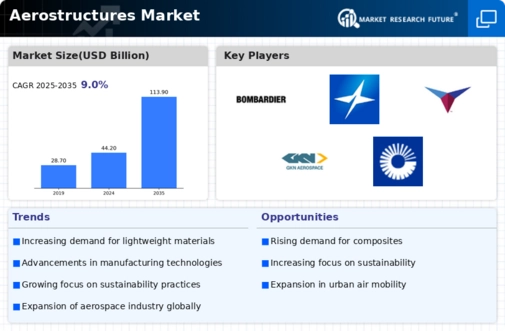Top Industry Leaders in the Aerostructures Market

Strategies Adopted: Key players in the Aerostructures Market employ various strategies to maintain their competitive edge and capitalize on market opportunities. These strategies include:
Technological Innovation: Companies invest heavily in research and development to develop advanced materials, manufacturing processes, and design techniques that improve the performance, efficiency, and sustainability of aerostructures while reducing weight and production costs.
Vertical Integration: Vertical integration across the supply chain, including design, engineering, manufacturing, and aftermarket services, allows companies to control quality, lead times, and costs, ensuring seamless coordination and collaboration throughout the product lifecycle.
Strategic Partnerships: Collaborations with aircraft OEMs, suppliers, research institutions, and government agencies help companies secure long-term contracts, access new markets, and leverage complementary capabilities and resources to drive innovation and growth.
Global Expansion: Key players focus on expanding their geographical footprint through acquisitions, joint ventures, and partnerships in strategic locations to better serve their customers, gain market share, and mitigate risks associated with geopolitical and economic uncertainties.
Key Players:
AAR Corp. (US),
Bombardier Inc. (Canada),
Ruag Group (Switzerland),
Saab AB (Sweden),
Spirit Aerosystems, Inc. (US),
Stelia Aerospace Group (France),
Triumph Group, Inc. (US),
Cyient Ltd (India),
Elbit Systems Ltd (Israel),
GKN Aerospace (UK),
Leonardo SpA (Italy),
UTC Aerospace Systems (US).
Factors for Market Share Analysis: Several factors contribute to the analysis of market share in the Aerostructures Market, including:
OEM Relationships: Strong relationships with aircraft OEMs, such as Airbus, Boeing, and Embraer, are crucial for securing contracts and winning market share, as OEMs often prefer to work with trusted suppliers with proven track records of quality, reliability, and on-time delivery.
Manufacturing Capabilities: Advanced manufacturing capabilities, such as automated assembly lines, additive manufacturing (3D printing), and robotic machining, enable companies to produce aerostructures more efficiently, cost-effectively, and with higher precision, enhancing competitiveness and market share.
Innovation and Differentiation: Companies that differentiate themselves through technological innovation, unique design solutions, and value-added services, such as integrated systems, aftermarket support, and sustainment solutions, often gain a competitive advantage and capture a larger share of the market.
Regulatory Compliance: Compliance with stringent aviation regulations, standards, and certifications, such as AS9100, NADCAP, and FAA Part 21, is essential for gaining market share and securing contracts in the highly regulated aerospace industry.
New and Emerging Companies: In addition to established players, new and emerging companies are entering the Aerostructures Market, bringing innovative technologies and solutions. These companies often focus on niche segments or disruptive approaches, challenging traditional players and driving innovation in the industry. Some notable new and emerging companies in the market include:
Aerostructures Engineering Services GmbH
Aernnova Aerospace S.A.
FACC AG
Avcorp Industries Inc.
Kaman Corporation
TenCate Advanced Composites (Teijin Limited)
Solvay S.A.
Mitsubishi Heavy Industries Aerostructures, Ltd.
Industry News and Current Investment Trends: Recent developments and investment trends in the Aerostructures Market reflect a growing focus on sustainability, digitalization, and aftermarket services. Key highlights include:
Sustainable Materials: Companies are exploring sustainable materials, such as advanced composites, lightweight alloys, and bio-based resins, to reduce environmental impact, improve fuel efficiency, and comply with emissions regulations.
Digital Transformation: Digitalization initiatives, such as digital twins, smart manufacturing, and predictive maintenance, enable companies to optimize production processes, enhance quality control, and provide value-added services to customers, driving operational efficiency and customer satisfaction.
Aftermarket Growth Opportunities: With an increasing focus on fleet modernization, upgrades, and modifications, aftermarket services, including repair, overhaul, and retrofit solutions, offer significant growth opportunities for companies in the Aerostructures Market, as airlines seek to extend the lifespan and performance of their aircraft fleets.
Overall Competitive Scenario: The Aerostructures Market is highly competitive, characterized by technological innovation, vertical integration, and global expansion. Established players leverage their scale, expertise, and customer relationships to maintain market leadership, while new entrants disrupt the market with novel technologies and business models. As the aerospace industry evolves, companies that focus on agility, resilience, and customer-centricity will thrive in the competitive landscape of the Aerostructures Market.
Recent Developments:
The Covid outbreak has impacted the aviation and protection area also. In the main quarter of 2002, the Boeing organisation and the Airbus SE just enlisted conveyance of 70 and 196 aeroplanes. However, in the year 2019, during a similar measure of time, both organisations conveyed around 389 planes.
Due to the Coronavirus pandemic, the public authority all over the planet chose to force lockdown and gave social removal rules, and it profoundly impacted numerous business associations, including aviation.
In August 2019, the US airforce granted the Boeing organisation a $999 million agreement for A-10 wing substitution.










